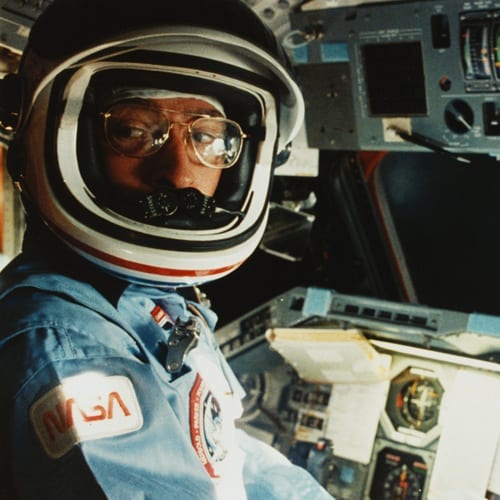*Image courtesy of NASA
On January 5, the nation and the world lost a very courageous astronaut and an outstanding engineer, and I lost a very good friend. John Young was a pioneer who led the way in space exploration. There will never be another like him.
During my early years at the Manned Spacecraft Center (MSC) while I was working on the Apollo Program, John was very much involved in the Gemini Program. He flew his first mission in space with Gus Grissom on Gemini 3, in March 1965. John flew his second Gemini mission in July 1966 as the commander of Gemini 10 with Mike Collins. I had met John but did not get to know him well until he, Tom Stafford and Gene Cernan were assigned as the back-up crew for Apollo 7. In 1967 while working as technical assistant for George Low, the Apollo program manager, I had the privilege to interface frequently with John, Tom and Gene. I came to have great respect for John’s technical capabilities and his dedication to the space program. Faced with overwhelming amounts of technical data, John had the unique ability to clearly identify the critical technical issues and problems and their impact on operations. I have never encountered anyone else that could do that any better than John. My respect for him grew as he went on to fly to the moon with Tom Stafford and Gene Cernan on Apollo 10 in May 1969, the dress rehearsal for Apollo 11.
After the flight of Apollo 12, in November 1969, I became technical assistant to the director of MSC, Robert Gilruth, and his deputy, Chris Kraft. Dr. Gilruth told me that he wanted me to read all his mail and let him know what he needed to see. However, he said there was one exception: if he received a memorandum from John Young, he wanted to see it immediately. He explained that John was the best engineer he had working for him and if John had a concern, then he also had a concern.
Eighteen years later in the spring of 1984, George Low had retired from NASA. While serving as the president of Rensselaer Polytechnic Institute, he was hospitalized at MD Anderson Cancer Center, suffering from recurrent melanoma. John and I went to visit George in the hospital. George was quite pleased to see us and proceeded to tell about his plans after his recovery. He told us that he was going to take up golf, as many friends told him that a good bit of business is conducted on the golf course. Suddenly, he hesitated and then said, “John, I really didn’t mean it.” John replied, “no, golf is fine.” George said, “John, I can see it in your eyes, I’m not really going to take up golf.” And then he said, “There is something else I have always wanted to tell and never had the opportunity, the memorandum you wrote to me when I managed the Apollo program meant more to me than anything I ever received. I treasured them and responded to them and had always wanted to express my thanks to you, John.” George passed away that July.
Lunar science received great emphasis on the last three Apollo missions, and John was assigned as the commander of Apollo 16, the next-to-last Apollo mission. To prepare for his lunar surface activities, he devoted considerable effort to understanding lunar geology; his outstanding performance on the lunar surface won him the respect of two of the prominent geologists involved in the flight, Lee Silver of the California Institute of Technology and Bill Muhlberger of the University of Texas. John had a continuing interest in the moon and its geology. After his flight he religiously attended each of the annual Lunar and Planetary Science conferences that have been held every March since 1970.
I became the Director of Flight Operations in 1976 and was most fortunate to have John as the head of the Astronaut Office. We developed a close relationship that continued throughout the remainder of our NASA careers and beyond. He became my closest advisor and confidante. That relationship continued during my assignments in Washington, D.C., at NASA headquarters and at the White House and upon my return to the Johnson Space Center in 1994.
I have great memories of my longtime friendship with John. Our time together at Edwards Air Force Base during the Shuttle Approach and Landing tests, at Cape Canaveral before each mission, our visit to Moscow during the protests against Russian President Boris Yeltsin in October 1993, and those clear, starry nights flying together in the T-38, listening to John point out each of the constellations and the major stars. My friend John is not gone, he will always be with me.
Vaya con Dios, mi amigo!
George Abbey, the institute’s Senior Fellow in Space Policy, is the former director of NASA’s Johnson Space Center in Houston.
